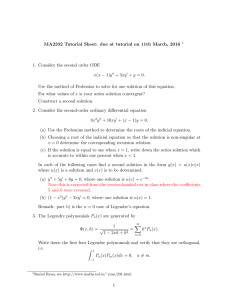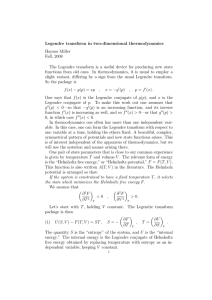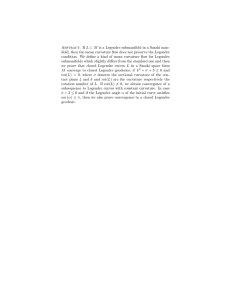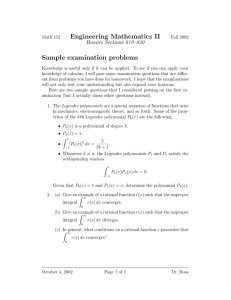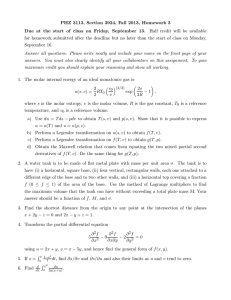Legendre Transforms for Dummies Carl E. Mungan Physics Department
advertisement
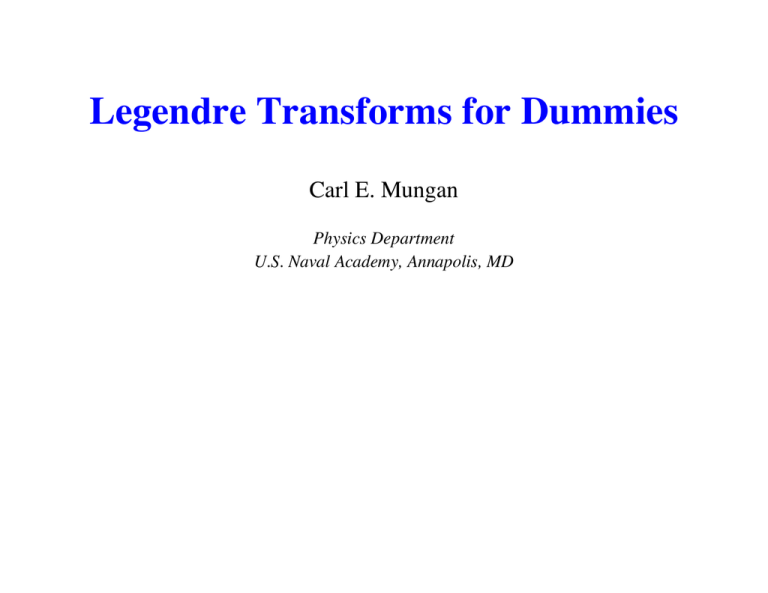
Legendre Transforms for Dummies Carl E. Mungan Physics Department U.S. Naval Academy, Annapolis, MD Poster PST2-F03 AAPT Summer Meeting 29 July 2014 Minneapolis, MN Abstract Legendre transforms appear in two places in a standard undergraduate physics curriculum: (1) in classical mechanics when one switches from Lagrangian to Hamiltonian dynamics, and (2) in thermodynamics to motivate the connection between the internal energy, enthalpy, and Gibbs and Helmholtz free energies. Both uses can be compactly motivated if the Legendre transform is properly understood. Unfortunately, that transform is often relegated to a footnote in a textbook, or worse is presented as a complicated mathematical procedure. In this poster, I simplify the idea to the point that the Legendre transform can be elegantly presented in class in a sensible and accessible manner. In a nutshell, a Legendre transform simply changes the independent variables in a function of two variables by application of the product rule. History The transform is named after the French mathematician Adrien-Marie Legendre (1752–1833). He is also noted for establishing the modern notation for partial derivatives, which was subsequently adopted by Carl Jacobi in 1841, as well as for work on his eponymous differential equation and polynomials. What is a Legendre transform used for? A Legendre transform converts from a function of one set of variables to another function of a conjugate set of variables. Both functions will have the same units. ! to the Hamiltonian H ( x, p ) . Here the velocity x! eg. 1) Convert from the Lagrangian L(x, x) and the linear momentum p are conjugate variables, and both L and H have units of energy. eg. 2) Convert between the internal energy U, enthalpy H, Helmholtz free energy F, and Gibbs free energy G. The two conjugate pairs of variables are pressure P and volume V, and temperature T and entropy S. (Optionally, the chemical potential µ and number of particles N can be added in as another conjugate pair.) All of these thermodynamic potentials have units of energy. How does a Legendre transform work? The key idea is to use the product rule. If ( x, y ) is a conjugate pair of variables, then d ( x y ) = xdy + ydx relates the variation dy in quantity y to the variation dx in quantity x. eg. 1) x! p has the same units as L and H eg. 2) PV and TS have the same units as U, H, F, and G Mathematical details Consider a function of two independent variables, call it f ( x, y ) . Its differential is ⎛ ∂f ⎞ ⎛ ∂f ⎞ df = ⎜ ⎟ dx + ⎜ ⎟ dy . ⎝ ∂x ⎠ y ⎝ ∂y ⎠ x (1) Defining u ≡ ( ∂f ∂x ) y and w ≡ ( ∂f ∂y ) x , Eq. (1) can be rewritten as df = u dx + w dy . (2) We call u and x a conjugate pair of variables, and likewise w and y. We can recognize our original variables x and y of the function f because the right-hand side of Eq. (2) is written in terms of differentials of those two variables. Proceeding, use the product rule (or equivalently, integration by parts) to compute the differential d ( wy ) = y dw + wdy (3) and subtract this equation from Eq. (2) to get dg = u dx − y dw (4) where I have introduced the Legendre-transformed function g ≡ f − wy . Since we are taking differentials of x and w, we can take those two quantities as the independent variables of the new function, g ( x, w) . To summarize, we have done a Legendre transformation from an original function f ( x, y ) to a new function g ( x, w) by switching from variable y to its conjugate variable w. Of course, one could instead switch x to u to obtain h(u, y ) or one could switch both independent variables to get k (u, w) . We see therefore that for two variables, there are 4 possible variants on the function. To make contact with thermodynamics, we might call these various functions the potentials. If instead we have 3 independent variables, there are 8 different potentials, or in general there are 2n potentials for a function of n independent variables, since each variable can be represented by either member of a conjugate pair. Example 1: Legendre transform from the Lagrangian L to the Hamiltonian H Suppose we have a mechanical system with a single generalized coordinate q and corresponding velocity q! . Then the Lagrangian is defined as the difference between the kinetic ! ! K " U . We wish to transform to a new function H (q, p ) where and potential energies, L(q, q) p is the momentum. To apply the formalism developed above, we merely have to make a table of equivalences: f ! L (the original function) x ! q (the variable we are not switching) y ! q! (the variable to be switched) #"f & # "L & w!% = % ( ! p (the conjugate of the switched variable) ( $ " y ' x $ "q! ' q where the last equality is the definition of the canonical momentum. For example, if q is the ordinary one-dimensional position x of a particle of mass m, so that q! = ! is the velocity and K = 12 mυ 2 is the kinetic energy, then " !L % " !K % $# !q! '& = $# !( '& = m( = p , q x (5) noting that, because potential energy U is conservative, it cannot be a function of the velocity but only of the position. Anyhow, returning to our table of equivalences, the transformed function is g ! f " w y = L " pq! (6) which defines the negative of the Hamiltonian H (q, p ) . We take the negative so that H can be conveniently related to the energy. For the simple example above, pq! ! L = (m" )(" ) ! ( 1 m" 2 2 ) !U = K +U = H so that the Hamiltonian in this case is the total energy of the system. (7) Example 2: Legendre transform from internal energy U to enthalpy H Suppose we have a system (such as a fixed quantity of gas) for which we have chosen the independent variables to be the entropy S and volume V. Then according to the thermodynamic identity, dU = T dS − P dV (8) where the temperature T and pressure P are therefore the variables conjugate to the entropy and volume, respectively. We wish to transform from U ( S ,V ) to a new thermodynamic potential H ( S , P) . We again construct a table of equivalences: f ≡ U (the original function) x ≡ S (the variable we are not switching) ⎛ ∂f ⎞ ⎛ ∂U ⎞ u ≡⎜ ⎟ =⎜ ⎟ = T (the conjugate of the unswitched variable) ⎝ ∂x ⎠ y ⎝ ∂S ⎠V y ≡ V (the variable to be switched) ⎛ ∂f ⎞ ⎛ ∂U ⎞ w≡⎜ ⎟ =⎜ ⎟ = − P (the conjugate of the switched variable) ⎝ ∂y ⎠ x ⎝ ∂V ⎠ S where the partial derivatives of U were calculated from Eq. (8). The transformed function is g ≡ f − wy = (U ) − (− P)(V ) = U + PV ≡ H (S , P) . (9) In accord with Eq. (4), its differential is dH = T dS + V dP . Formulas for the Gibbs free energy G (T , P) and the Helmholtz free energy F (T , V ) can be similarly obtained. (10) Graphical interpretation An alternative way to introduce the Legendre transform uses a graphical method. For simplicity, consider a function of a single variable, f ( x) . The slope of this function is u = df / dx . Figure 1 shows a point P at coordinate x on the graph of, as a specific example, the function f ( x) = e x−1. The tangent line at P is drawn in red. Its intersection with the vertical axis of the graph defines the hypothesis of the blue triangle whose run has length x and whose rise (equal to the slope times the run) has height ux. Noting that f ( x) is the height of point P above the x axis, then we see that the Legendre transform g (u ) = f ( x) − ux can be simply interpreted as the vertical intercept of the red slope line. For the specific function graphed in Fig. 1, we have u= df = e x−1 ⇒ x = 1 + ln u dx (11) so that g (u ) ≡ f ( x) − xu = u − (1 + ln u )u = −u ln u (12) which is graphed in Fig. 2. Note that g (0) corresponds to f min = f (−∞) where the slope of f is zero, and that g (1) corresponds to f (1) where the slope of f is unity. In this particular example, f ( x) has positive slope u for all values of x and thus g (u ) is undefined for negative u. This graphical approach emphasizes that the Legendre transform will be single-valued only for a convex function. That is, a line segment joining any two points on the graph of f cannot lie anywhere below the graph. (This definition holds for a function of any number of variables.) The function cannot have any inflection or saddle points. FIGURE 1. 𝑓𝑓 𝑥𝑥 = 𝑒𝑒 𝑥𝑥−1 slope u P ux g x f FIGURE 2. 𝑔𝑔 𝑢𝑢 = −𝑢𝑢ln(𝑢𝑢) 0 1 Inverse Legendre transform According to Eq. (4), ⎛ ∂g ⎞ y = −⎜ ⎟ ⎝ ∂w ⎠ x (13) and we find the inverse transform by adding Eq. (3) to (4) to get (2). To avoid the minus sign in this equation for y, the Legendre transform can alternatively be defined as g ≡ wy − f , in which case the Legendre transform is its own inverse, since f = wy − g , rather than being the negative of its inverse. This opposite-sign alternative definition, which was used in connection with Eq. (6), has the advantage that it gives rise to the symmetric identity f + g = wy (14) which in words says that the sum of a function and its Legendre transform equals the product of the conjugate pair of variables. It is worth re-emphasizing the dimensional consistency of this identity. Equation (14) is actually a function of either w or y but not both, because one variable implicitly depends on the other via a Legendre transform. Derivative relation for the Legendre transform Starting from ⎛ ∂f ⎞ g = f − wy = f − y ⎜ ⎟ ⎝ ∂y ⎠ x (15) we see that g y 2 = ⎛ ∂ f ⎞ 1 ⎛ ∂f ⎞ − ⎜ ⎟ = −⎜ ⎟ y ⎝ ∂y ⎠ x y ⎝ ∂y y ⎠ x f 2 ⇒ ⎛ ∂ f⎞ g ( x, y ) = − y 2 ⎜ ⎟ ⎝ ∂y y ⎠ x (16) which gives another way to compute the Legendre transform g from the givens f, x, and y. For the thermodynamic example given above, Eq. (16) becomes ⎛ ∂ U⎞ . H (S ,V ) = −V 2 ⎜ ⎟ ⎝ ∂V V ⎠S (17) We can check this relation for a monatomic ideal gas, in which case U = 32 PV . For a reversible adiabatic compression, we know that PV 5/3 = k is a constant. Thus 3 −5/3 5 ⎛U ⎞ ⇒ H = PV ⎜ ⎟ = kV 2 ⎝ V ⎠S 2 according to Eq. (17), which is indeed consistent with H = U + PV . (18) Other applications in classical and statistical mechanics Consider a relativistic particle of mass m, so that its Hamiltonian is equal to the total energy H (q, p) = p 2c 2 + m2c 4 + U (q) (19) where p is the linear momentum of the particle, c is the speed of light, and U is the potential energy which only depends on the generalized coordinate q. The variable conjugate to p is the velocity q! ! " and is equal to the slope of the Hamiltonian, ⎛ ∂H ⎞ ⎟ = ⎝ ∂p ⎠q υ =⎜ pc 2 2 2 2 4 p c +m c (20) where the first equality is alternatively recognized as one of Hamilton’s equations. One can straightforwardly invert this equation to obtain the familiar result p = γ mυ where γ ≡ (1 − υ 2 / c2 )−1/2 . The Legendre transform of H gives the Lagrangian, ! ! " p # H = #$ #1mc 2 # U (q) L(q, q) (21) which is not equal to K − U . However, the Lagrange equation correctly gives F = dp / dt where the force is F = −dU / dq . If k is the Boltzmann constant, one can define the dimensionless Helmholtz free energy as ! ! ,V ) = !U " S! F! ! F / kT and the dimensionless entropy as S! ! S / k . Then the fact that F( shows that internal energy U and reciprocal temperature β ≡ 1/ kT are conjugate variables, in terms of which entropy is the Legendre transform of the free energy. The thermodynamic identity becomes dF! = Ud ! " # dV which shows that volume V and the pressure-temperature ratio η ≡ P / kT are also conjugates. Select references [1] R.K.P. Zia, E.F. Redish, and S.R. McKay, “Making sense of the Legendre transform,” Am. J. Phys. 77, 614–622 (July 2009). [2] Ralph Baierlein, Thermal Physics (Cambridge Univ. Press, 2005), pp. 240–241. [3] M. Scott Shell, Thermodynamics and Statistical Mechanics: An Integrated Approach (Cambridge Univ. Press, 2014), Chap. 7. [4] S. Kennerly, “A graphical derivation of the Legendre transform,” PDF online at http://www.physics.drexel.edu/~skennerly/maths.html.
